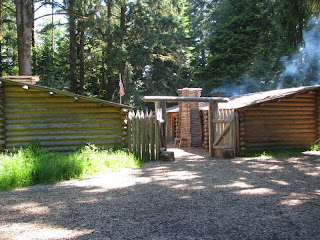August 28-29, 2012 – Natural Bridges National Monument, UT
We left Knotty Pine Park on Tuesday morning and headed south. We took Hwy. 24 south of I-70 which runs west
of Arches and Canyonlands National Parks.
This was a beautiful drive through and area we had not seen before. We spent the night in Blanding, UT and on
Wednesday drove out to Natural Bridges National Monument. In 1883 a prospector looking for gold went
into White Canyon and discovered three natural bridges that the water had
sculpted from stone. In 1904 National
Geographic Magazine publicized the bridges, and in 1908 President Theodore
Roosevelt established Natural Bridges National Monument, creating Utah’s first
National Park System area.
.JPG) We
visited the Visitors Center where we learned about how the bridges were formed
and how bridges differ from arches.
Natural bridges are formed by the erosive action of moving water and
arches are formed by other erosive forces, mainly frost action and seeping
moisture. We then drove the 9-mile Bridge
View Drive loop road that follows White Canyon. We stopped at an overlook where we could get
a good view of part of this beautiful canyon.
We
visited the Visitors Center where we learned about how the bridges were formed
and how bridges differ from arches.
Natural bridges are formed by the erosive action of moving water and
arches are formed by other erosive forces, mainly frost action and seeping
moisture. We then drove the 9-mile Bridge
View Drive loop road that follows White Canyon. We stopped at an overlook where we could get
a good view of part of this beautiful canyon.
Sipapu
Bridge is the highest at 220 ft and has the longest span, 268 ft, of the three
natural bridges. It is 31 feet wide and
53 ft thick - very impressive from the overlook.
Nancy
was not up to hiking to the base of the bridge, so we hiked a short trail to
another overlook. We had to climb a
ladder and many steps down to reach the overlook. This beautiful wall with lots of “desert varnish”
was along the trail.
The
trail climbed down to another overlook that gave a great view of the back side
of the bridge.
.JPG) We next stopped at Horse Collar Ruin where we took a short
hike to an overlook. Horse Collar Ruin
is a well preserved prehistoric site.
Inhabited by the Anasazi between A.D. 1050 and A.D. 1300, this site is
unusual because it contains both round and square kivas representing two
different architectural styles. The
round kiva is associated with the Mesa Verde Anasazi of southwestern Colorado
and southeastern Utah while the square kiva is indicative of the Kayenta
Anasazi of northern Arizona. Horse
Collar Ruin exhibits a strong Kayenta tradition during the early period of
occupation and a Mesa Verde influence dominating the later period of use. It was hard to get a picture of the ruins
because of the shadows.
We next stopped at Horse Collar Ruin where we took a short
hike to an overlook. Horse Collar Ruin
is a well preserved prehistoric site.
Inhabited by the Anasazi between A.D. 1050 and A.D. 1300, this site is
unusual because it contains both round and square kivas representing two
different architectural styles. The
round kiva is associated with the Mesa Verde Anasazi of southwestern Colorado
and southeastern Utah while the square kiva is indicative of the Kayenta
Anasazi of northern Arizona. Horse
Collar Ruin exhibits a strong Kayenta tradition during the early period of
occupation and a Mesa Verde influence dominating the later period of use. It was hard to get a picture of the ruins
because of the shadows.
The
next bridge along the drive was Kachina Bridge.
Kachina Bridge is the youngest of the three bridges and is still being
eroded by White Canyon flood waters. It
is 210 ft high, has a span of 204 ft and is 44 ft wide and 93 ft thick. We could not see completely under the bridge
from the overlook.
Owachomo
Bridge is the oldest of the three bridges and, although it is no longer being
eroded by the stream, frost and seeping moisture are still working on it. Owachomo is 106 ft high, spans 180 ft and is
27 ft wide and 9 ft thick.
We
did hike to the base of this bridge where we had a picnic lunch in the shade
and enjoyed the beauty of this bridge up close.
We really enjoyed our day at Natural Bridges National Park
and are constantly amazed at the beauty of our country.
Wednesday evening we drove to Monticello, UT
where we enjoyed visiting with Mary Jane, a friend from our RV Park in Arizona.


.JPG)
.JPG)




.JPG)

Comments
Post a Comment